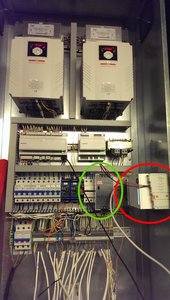During the development of this 3-year project different field trials in the Grundfos Dormitory Lab were developed to validate our research hypotheses. Here you can find a description of the principal field trials.
Depending on the people involvement we have identified three different types of interventions:

The ventilation system control is a back-stage intervention where the demand response potential of the ventilation system at Grundfos Dormitory Lab was analysed. With that goal in mind, the ventilation system in the test bed has been extended to enable remote and secure controllability over the Internet. The result showed that one ventilation system by itself can indeed react fast enough to satisfy time constraints of ancillary services in Denmark. However, the minimum power bids to be provided to the market make unfeasible the participation of a single ventilation system. More details on this field trial can be read in this publication [1].

Green Lift is a front-stage intervention where the demand response potential of the elevator in Grundfos Dormitory Lab is analysed. The main idea was to provide the residents with information about “good” and “bad” periods to take the elevator, from a CO2 grid emission intensity perspective. LEDs were deployed in a one-month intervention as shown in the figure. The LEDs flashed red when the electricity generation was pollutant, thereby encouraging the residents to take the stairs, and green when electricity came from renewable energy sources, encouraging the residents to take the elevator. Electricity consumption in the elevator and door opening were monitored during the field trial. In general Green Lift was successful in motivating more stair case usage and the residents were quite positive about this intervention, even though they found it a bit hard to understand that in some time periods they were encouraged to take the elevator. More details on this field trial are provided in this publication [2].

ShareBuddy is a casual mobile game designed to engage the residents at the Grundfos Dormitory Lab in reducing or shifting their consumption. The overall concept of the game is that residents try to reduce or shift consumption in real life to earn resources for their buddy in the game, enabling the buddy to carry out different daily routines like showering, eating or tooth brushing and thereby earn points. This intervention increased energy awareness of the residents but residents found it difficult to understand the concept of shifting energy usage.
More details on this intervention are provided in this publication [3].

Clock Cast is a front-stage intervention were the overall goal was to make the energy forecast visible in a different way through the presence of a physical clock, showing the next ”good” hour to consume energy. In addition to the physical clock, participants also had access to a web forecast, and we sent them text messages with suggestions for how to match their consumption to the forecast. The main findings of this intervention were that shifting requires the ability to plan ahead, thus limiting the activities to be shifted to doing laundry, dishwashing and tumble drying Having the physical clock raised energy awareness but by itself is not enough to shift energy.
1 Sergi Rotger-Griful, Rune Hylsberg Jacobsen, Dat Nguyen, and Gorm Sørensen. Demand Response Potential of Ventilation Systems in Residential Buildings. Energy and Buildings, 2016. doi: 10.1016/j.enbuild.2016.03.061
2 Sergi Rotger-Griful, Rune Hylsberg Jacobsen, Robert Stephen Brewer, and Mia Kruse Rasmussen. Green Lift: Exploring the Demand Response Potential of Elevators in Buildings. Building and Environment, 2016. Under review
3 Robert S. Brewer, Nervo Verdezoto, Thomas Holst and Mia Kruse Rasmussen. Tough Shift: Exploring the Complexities of Shifting Residential Electricity Use Through a Casual Mobile Game. In CHI PLAY '15. doi: 10.1145/2793107.2793108